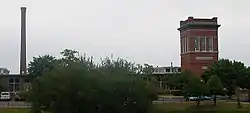Plymouth Cordage Company
The Plymouth Cordage Company was a rope making company located in Plymouth, Massachusetts, USA. The company, founded in 1824, had a large factory located on the Plymouth waterfront. By the late 19th century, the Plymouth Cordage Company had become the largest manufacturer of rope and twine in the world.[1] The company specialized in ship rigging, and was chosen among other competitors in the early 1900s to manufacture the rope used on the USS Constitution. The company's twine, Plymouth binder twine, popular among farmers, was the inspiration for the naming of the Plymouth brand of automobiles first produced in 1928.

The Plymouth Cordage Company served as the largest employer in Plymouth for over 100 years. It went out of business in 1964 after over 140 years of continuous operation. By the early 1960s, it had bought all the materials needed for production, had no debt and a lot of cash and was bought out by the Columbian Rope Company in 1965.
A member of the Peabody family which had long been investors acquired rights to the brand and relocated a portion of the equipment to Haiti to continue producing sisal rope.
Parts of the original machinery and 1/3 of the original rope walk building is now on display at Mystic Seaport in Mystic, Connecticut. The original rope walk building was 110 feet, the length needed to twist a 90 foot long rope. Rope was made manually until the 1890s. To make rope, men put fibers around their waist and walked backward down the rope walk as they twisted the fibers in a process similar to how yarn is made. The twisted pieces were stored on pegs on the wall. Eventually another man wound the twisted fibers on a wheel. A model of the rope walk is on display at the Plymouth Cordage Museum in the original mill #3, under the tower. The museum is open noon to 4pm each weekend includes over 2,000 original items and publications donated by prior employees and their relatives.
The Plymouth Cordage Company played a small role in the Sacco and Vanzetti case. Bartolomeo Vanzetti worked at the company in the early part of the century. Upton Sinclair's historical novel "Boston" has several chapters devoted to the company when his elderly heroine goes to work for the factory.
Plymouth Cordage also operated a factory in Welland, Ontario. A detailed history of Welland operations can be found at the Welland Public Library Local History site.[2]
Cordage Commerce Center

In modern times, the 45-acre (180,000 m2) Cordage factory property in North Plymouth has been turned into a large retail and office center. The building, now known as Cordage Commerce Center, houses the Plymouth MBTA station, a terminus for the Old Colony Line. The factory also contains several restaurants, offices, and stores. University of Massachusetts Boston currently offers some classes in a wing of the building. The largest retailer is Mill Stores. There was previously a Wal-Mart located on the property, but it closed in 2005 and relocated to Colony Place, also in Plymouth.
In 2012, much of the former plant was demolished due to deterioration related to the quick construction of the facility in 1899. Plans for the site include the eventual building of condominiums.[3]
References
- "Plymouth Cordage Company: Storied Past". Cordage Commerce Center. Archived from the original on September 27, 2007. Retrieved August 12, 2007.
- "Plymouth Cordage Company History". Retrieved February 1, 2009.
- Harbert, Rich (April 7, 2012). "PLYMOUTH CORDAGE COMPANY: The walls come tumbling down". Wicked Local Plymouth. Retrieved August 21, 2014.
Archives and records
- Plymouth Cordage Company records at Baker Library Special Collections, Harvard Business School.